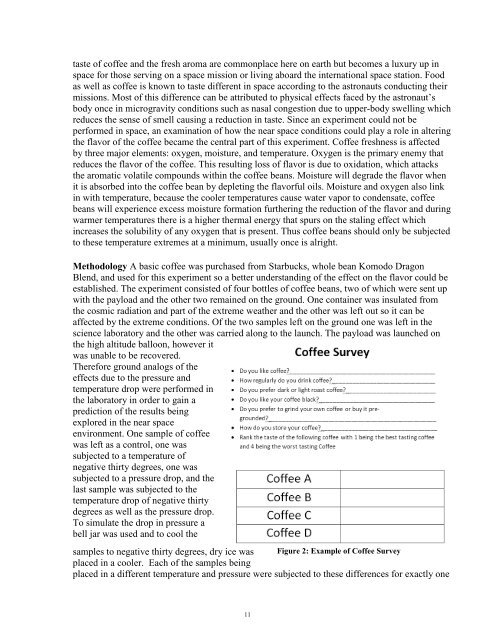Space Grant Consortium - University of Wisconsin - Green Bay
Space Grant Consortium - University of Wisconsin - Green Bay
Space Grant Consortium - University of Wisconsin - Green Bay
Create successful ePaper yourself
Turn your PDF publications into a flip-book with our unique Google optimized e-Paper software.
taste <strong>of</strong> c<strong>of</strong>fee and the fresh aroma are commonplace here on earth but becomes a luxury up in<br />
space for those serving on a space mission or living aboard the international space station. Food<br />
as well as c<strong>of</strong>fee is known to taste different in space according to the astronauts conducting their<br />
missions. Most <strong>of</strong> this difference can be attributed to physical effects faced by the astronaut’s<br />
body once in microgravity conditions such as nasal congestion due to upper-body swelling which<br />
reduces the sense <strong>of</strong> smell causing a reduction in taste. Since an experiment could not be<br />
performed in space, an examination <strong>of</strong> how the near space conditions could play a role in altering<br />
the flavor <strong>of</strong> the c<strong>of</strong>fee became the central part <strong>of</strong> this experiment. C<strong>of</strong>fee freshness is affected<br />
by three major elements: oxygen, moisture, and temperature. Oxygen is the primary enemy that<br />
reduces the flavor <strong>of</strong> the c<strong>of</strong>fee. This resulting loss <strong>of</strong> flavor is due to oxidation, which attacks<br />
the aromatic volatile compounds within the c<strong>of</strong>fee beans. Moisture will degrade the flavor when<br />
it is absorbed into the c<strong>of</strong>fee bean by depleting the flavorful oils. Moisture and oxygen also link<br />
in with temperature, because the cooler temperatures cause water vapor to condensate, c<strong>of</strong>fee<br />
beans will experience excess moisture formation furthering the reduction <strong>of</strong> the flavor and during<br />
warmer temperatures there is a higher thermal energy that spurs on the staling effect which<br />
increases the solubility <strong>of</strong> any oxygen that is present. Thus c<strong>of</strong>fee beans should only be subjected<br />
to these temperature extremes at a minimum, usually once is alright.<br />
Methodology A basic c<strong>of</strong>fee was purchased from Starbucks, whole bean Komodo Dragon<br />
Blend, and used for this experiment so a better understanding <strong>of</strong> the effect on the flavor could be<br />
established. The experiment consisted <strong>of</strong> four bottles <strong>of</strong> c<strong>of</strong>fee beans, two <strong>of</strong> which were sent up<br />
with the payload and the other two remained on the ground. One container was insulated from<br />
the cosmic radiation and part <strong>of</strong> the extreme weather and the other was left out so it can be<br />
affected by the extreme conditions. Of the two samples left on the ground one was left in the<br />
science laboratory and the other was carried along to the launch. The payload was launched on<br />
the high altitude balloon, however it<br />
was unable to be recovered.<br />
Therefore ground analogs <strong>of</strong> the<br />
effects due to the pressure and<br />
temperature drop were performed in<br />
the laboratory in order to gain a<br />
prediction <strong>of</strong> the results being<br />
explored in the near space<br />
environment. One sample <strong>of</strong> c<strong>of</strong>fee<br />
was left as a control, one was<br />
subjected to a temperature <strong>of</strong><br />
negative thirty degrees, one was<br />
subjected to a pressure drop, and the<br />
last sample was subjected to the<br />
temperature drop <strong>of</strong> negative thirty<br />
degrees as well as the pressure drop.<br />
To simulate the drop in pressure a<br />
bell jar was used and to cool the<br />
samples to negative thirty degrees, dry ice was Figure 2: Example <strong>of</strong> C<strong>of</strong>fee Survey<br />
placed in a cooler. Each <strong>of</strong> the samples being<br />
placed in a different temperature and pressure were subjected to these differences for exactly one<br />
11

















